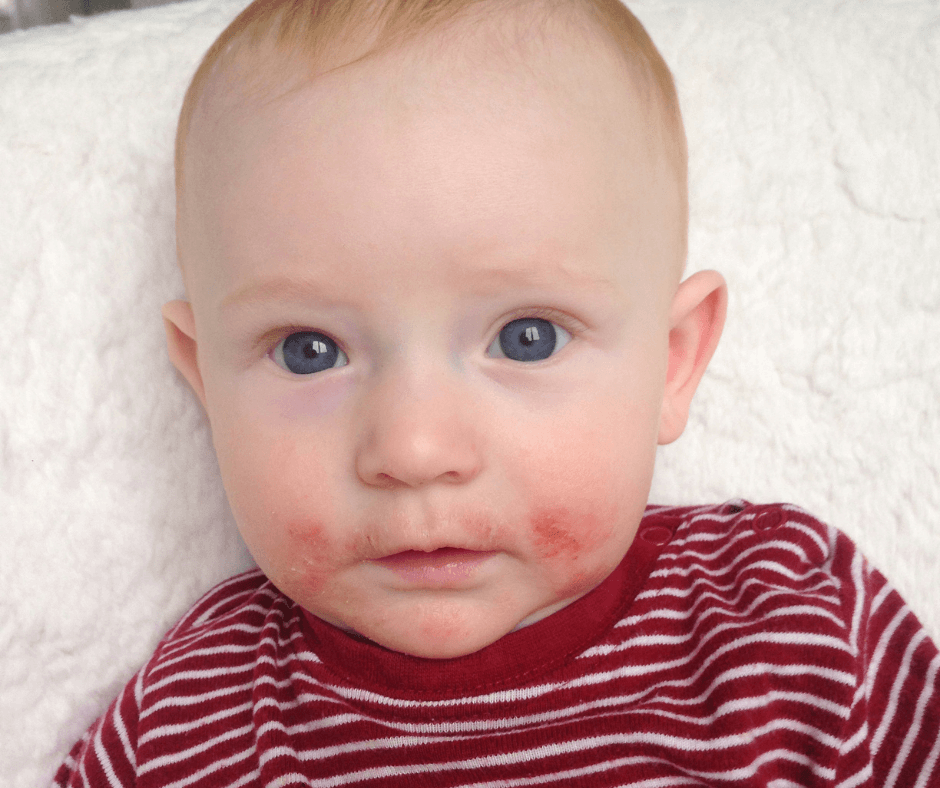Does My Baby Have a Food Allergy?
Wouldn’t it be great to have an app that interprets a baby’s cry? Often when a baby wails after feeding, they may just need to be burped. But how do we know if it’s something more serious like an allergy? Could the baby be allergic to something mom is eating and passing on in her breast milk? Some of the most likely suspects for food allergies include cow’s milk products, soy, wheat, corn, eggs, and peanuts. Babies can’t tell us what they’re feeling, so check for allergy symptoms after feedings.
Symptoms of Allergies in Babies
- Frequent spitting up
- Vomiting
- Signs of abdominal pain, such as excessive crying and irritability, especially after feedings
- Colic-like symptoms, especially after feedings
- Diarrhea
- A scaly skin rash
- Blood in stool
- Hives
- Coughing or wheezing
- Watery eyes and stuffy nose
- Trouble breathing or a bluish skin color
- Swelling (especially of the mouth and throat)
Diagnosing Allergies in Babies
Although many babies will display some of the less serious symptoms, it does not necessarily mean they have a food allergy. It can be something as simple as overfeeding, formula that has been mixed incorrectly, or mom’s diet causing excessive gas for the baby. However, since approximately 6% of children ages 0-2 years have a food allergy according to the American Academy of Allergy, it is still worth mentioning any of these symptoms to your child’s pediatrician. Doctors can determine whether the baby is allergic to certain foods through a skin prick test for babies older than 6 months.
Milk Allergy vs. Milk Intolerance
Note that there is a difference between milk allergies and milk intolerance. Milk allergies have to do with the proteins found in cow’s milk products in either the formula a baby is drinking, or from the dairy mom has been eating and passing on in her breastmilk. Babies will likely outgrow milk allergies by the age of 3. Milk intolerance is not related to milk proteins but has to do with the baby’s immune system. When a baby cannot digest the sugar in milk (lactose), they are considered lactose intolerant. However, milk intolerance in babies from birth is extremely rare. Lactose intolerance usually develops in childhood or adulthood.
What To Do if Your Baby Has a Food Allergy
If the skin prick test at the doctor’s office shows allergies to milk proteins, doctors will recommend that formula-fed babies switch to a hypoallergenic formula. These kinds of formula have milk proteins that are already partly broken down, making it easier for the baby to digest. Breastfeeding moms will have to stop eating dairy products. Unfortunately, dairy is found in a lot of foods so it may take some work to determine what is and is not acceptable to eat. Moms should make sure they are still getting calcium from other sources. Whatever the offending food is, mom will have to avoid it while breastfeeding while also being vigilant about getting all the calories and nutrients she needs. At the Motherhood Center, we hold nutrition classes covering prenatal and postpartum nutrition. If you think you might need some advice on how to get your nutrition needs met, check out our classes!
How to Determine Whether Baby is Allergic to a Certain Food
If your baby is younger than 6 months old and is not able to get a skin-prick test done, then you’ll have to do some detective work on your own:
Review Family Allergy History- Are there any foods you or other family members are allergic to? Allergies can sometimes be hereditary so make note of any known allergies and try to avoid those foods.
Food Journal- To pinpoint if a certain food could be the culprit, try keeping a food journal. Keep a record of the food you are eating and when you eat them. Then note the feeding times for the baby. Record baby’s symptoms and behavior after each feeding. See if you can find any correlation between baby’s behavior and what you’ve eaten in the past day or so.
Elimination Diet- If after some time of keeping a food journal you think you might have some suspects, then start an elimination diet. You might also want to start an elimination diet if you were not able to come to a conclusion through the food journal. The most common suspect is dairy so you might want to start there. Grains, gluten, fish and shellfish could be other choices as well. Remove just one suspect food from your diet for 2-3 weeks to see if it makes a difference in your baby’s post-feeding behavior. It may take a week or more before a baby shows improvement, especially if the food was a regular part of mom’s diet before. Certain aspects of a food (like milk proteins) can linger in our bodies for over a week. Is the baby fussing less? Have they stopped spitting up? If you see marked improvement, then this could be the allergen.
Mother’s Nutrition
It is important to note that fussiness after feeding is a typical part of infanthood and most likely not due to an allergy. Sometimes mothers may be needlessly restricting their diet to find a solution to a colicky baby when only time is required. Babies will grow out of colic at some point. If you really do suspect an allergy, be sure to discuss all options with a medical doctor and meet your own nutrition needs in the meantime as well.



